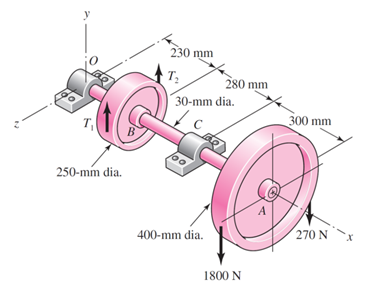A countershaft carrying two V-belt pulleys is shown in the figure. Pulley A receives power from a motor through a belt with the belt tensions shown. The power is transmitted through the shaft and delivered to the belt on pulley B. Assume the belt tension on the loose side at B is 15 percent of the tension on the tight side. Determine the tensions in the belt on pulley B, assuming the shaft is running at a constant speed. Find the magnitudes of the bearing reaction forces, assuming the bearings act as simple supports. Draw shear-force and bending-moment diagrams for the shaft. If needed, make one set for the horizontal plane and another set for the vertical plane.
A countershaft carrying two V-belt pulleys is shown in the figure. Pulley A receives power from a motor through a belt with the belt tensions shown. The power is transmitted through the shaft and delivered to the belt on pulley B. Assume the belt tension on the loose side at B is 15 percent of the tension on the tight side.
-
Determine the tensions in the belt on pulley B, assuming the shaft is running at a constant speed.
-
Find the magnitudes of the bearing reaction forces, assuming the bearings act as simple supports.
-
Draw shear-force and bending-moment diagrams for the shaft. If needed, make one set for the horizontal plane and another set for the vertical plane.
-
At the point of maximum bending moment, determine the bending stress and the torsional shear stress.
-
At the point of maximum bending moment, determine the principal stresses and the maximum shear stress.

Trending now
This is a popular solution!
Step by step
Solved in 4 steps with 2 images


